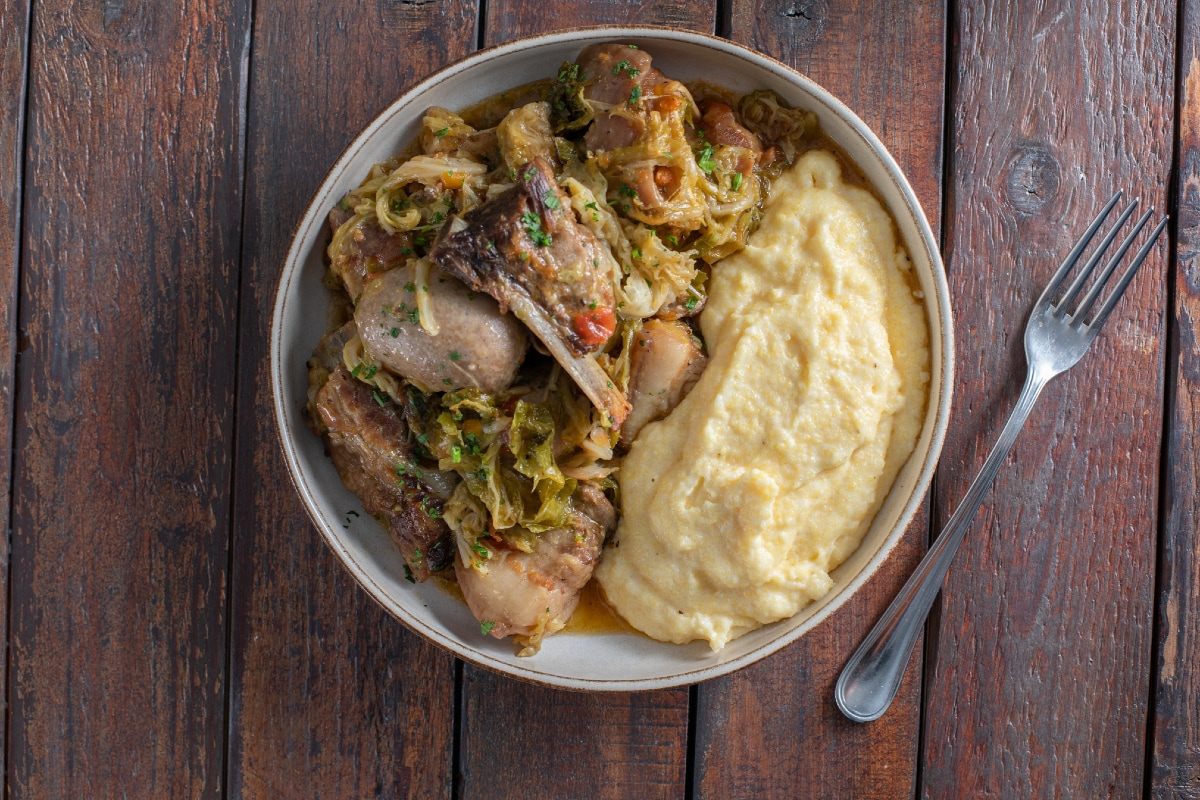Ossobuco Milanese (Braised veal shanks)
- Average
- 1 h 55 min

The cassoeula is a hearty one-pot meal based on cabbage and pork, typical of the Brianza cuisine. Its origins date back to peasant tradition when the pig was slaughtered and nothing went to waste. Claudio Sadler, a renowned star chef of Milanese origin, prepared this dish for us using the classic ingredients: pig's foot, snout, ear, tail, and skin, to which he added ribs and loin, a leaner cut of meat that deviates from the original recipe but integrates perfectly with everything else. Moreover, the verzini, fresh pork sausages typical of Lombardy, which are so named because they are cooked together with cabbage in the original cassoeula, cannot be missed. The queen, however, remains the cabbage, which plays a fundamental role in blending all the elements of the dish, whose ideal consistency is aptly described in this old Lombard saying: "La casoeûla l’ha da vess ben tacchenta e minga sbrodolada e sbrodolenta", meaning "the cassoeûla must be sticky and not brothy and runny"… the best way to enjoy it, in fact, is with a nice portion of polenta!
Don't miss these typical Lombard recipes as well:

To make the cassoeula, first, have your trusted butcher help you choose, cut, and clean the pork parts you will use. Prepare all the ingredients, starting with the cabbage: remove the green leaves from the outer part of the head 1 and the white leaves from the inner core 2, then cut them in half 3.

Blanch the green leaves in lightly salted boiling water for about ten minutes 4, then drain 5 and set aside. Do the same with the white cabbage leaves, keeping them separate from the green ones. Also, blanch the pieces of meat in lightly salted boiling water: immerse the skin 6 and drain it after 10 minutes.

Proceed in the same way with the ear 7, tail 8, foot, and snout 9. Also, blanch the ribs and verzini, always for 10 minutes. Drain and set aside.

Now move on to the tomatoes: briefly blanch them in boiling water 10, then peel them 11 and cut them into cubes 12. Set everything aside.

Finally, clean and cut the carrots into strips 13, the onion, and the celery. Heat the oil in a cast-iron casserole, then add the onion 14 and the carrots 15.

Add the celery 16 and let it stew gently, helping with a little water 17. Flavor with bay leaves 18 and a pinch of chopped garlic.

When the vegetables have softened, you can add the previously blanched pig's foot, tail, snout, and ear 19. Deglaze with white wine 20 and let the alcohol evaporate, then add the green cabbage leaves 21.

Pour in the chopped tomato pulp (only the more liquid part with the seeds) 22, mix 23, and cover with the lid 24. Cook for an hour and a half over medium-high heat.

In the meantime, prepare the flavored salt that you will use to cook the loin and ribs: make a very fine mince of rosemary, marjoram, parsley, and garlic, add the salt 25 and mix well 26. Season the loin cut into cubes with the flavored salt, massaging each piece well 27.

Transfer the loin to a baking sheet greased with oil 28, season with another drizzle of oil on top 29 and flavor with a clove of garlic and a bay leaf 30.

Do the same with the previously blanched ribs: massage the meat with the flavored salt 31, then transfer them to a greased baking sheet with oil and season with another drizzle of oil 32, bay leaf, and garlic 33. Bake both trays in a preheated static oven for 15 minutes.

After an hour and a half, the ingredients in the casserole will have started to blend, so you can add the remaining ones: add the skin 34 and a layer of white cabbage leaves 35, then pour in some of the chopped tomatoes 36.

Add the oven-cooked loin 37 and ribs 38, without their cooking juices, then pour in the remaining chopped tomatoes 39.

Finally, add the verzini 40 and cover with the last layer of white cabbage leaves 41. Season with a pinch of flavored salt and add a little water 42.

Flavor with some marjoram sprigs 43, then let it cook for at least another hour with the lid on, without stirring but occasionally checking that it doesn't dry out too much 44. At the end of cooking, garnish with parsley and marjoram leaves. Your cassoeula is ready to be served with a nice plate of polenta 45!